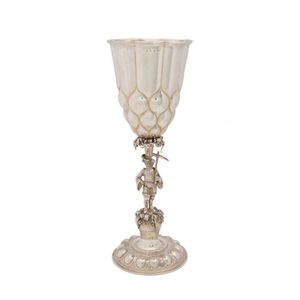16th Century Style Sterling Silver William Tell Chalice
You must be a subscriber, and be logged in to view price and dealer details.
Subscribe Now to view actual auction price for this item
When you subscribe, you have the option of setting the currency in which to display prices to $Au, $US, $NZ or Stg.
- Sterling Silver - Sterling silver is a mixture of 92.5% pure silver and 7.5% of another metal, usually copper. Fine silver is 99.9% pure silver, and is relatively soft and the addition of the very small amount of copper gives the metal enough strength and hardness to be worked into jewellery, decorative and household objects.
- Chalice - A chalice is a large cup or goblet that is used in religious ceremonies, particularly in Christian liturgical traditions. It is typically made of precious metal such as gold or silver, and is used to hold wine during the Eucharist, which is the central sacrament of the Christian Church. The chalice is also called the "cup of salvation" and is a symbol of Jesus' sacrifice on the cross.
In the Christian tradition, the chalice is a symbol of the blood of Jesus Christ, which is offered to the faithful as a means of grace and salvation. The chalice is used to hold the wine that is consecrated during the Eucharist and is considered to be a sacred object.
In the liturgical celebration of the Eucharist, it's passed around to the faithful, and the believer drinks from it to partake in the sacrament. Chalices are also used in other liturgical celebrations such as baptism, confirmation and anointing of the sick.
Chalices come in different shapes and sizes, from simple cups to highly ornate and decorative vessels, some of them are adorned with precious stones and intricate engravings. Chalices can also be used for other purposes, such as for holding holy water for baptism, or for the distribution of ashes on Ash Wednesday.
This item has been included into following indexes:
Visually similar items

An Australian silver trophy cup by Edward Fischer, Geelong, circa 1875 the bowl engraved 'Presented to the Grant & Polwarth Coursing Club by Donald Banlock Esq. for Competition between the Winners of the Derby & Oaks, May 28. 1878' and 'Won by Mr. Geo. Tho

Johan Rohde, sterling silver bowl, with grape and leaf pattern, of circular form with pierced stem depicting leaves and clusters of grapes on a spreading foot, design No. 197, impressed marks, manufactured for Georg Jensen, c. 1924, designed 1912. Diameter

A fine Venetian red glass and gold wine chalice, decorated with a scene of Neptune and consorts. Floral scrolls and latticework with white enamel dot outlines, height 16.5 cm

A Georg Jensen silver circular bowl, designed by Johan Rohde in 1912, Copenhagen, 1915/30, model No. 6, with a circular flared bowl raised on berried leaves and scrolls and stepped oval base, the base engraved 'Florence Stern Kahn - 1931', standard factory
